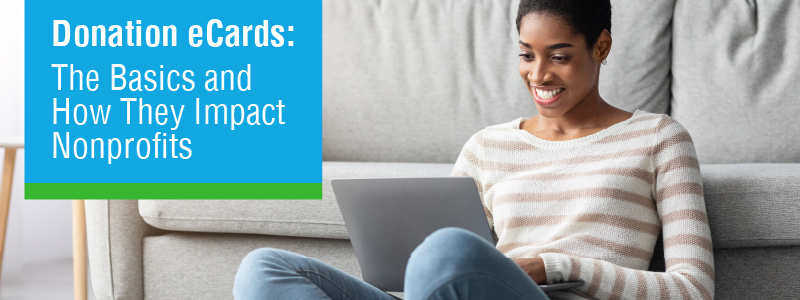
Schools run a lot of fundraisers and therefore need a lot of fundraising ideas. Experimenting with new fundraisers gives your school the chance to stumble upon one that resonates with your community and brings in vital revenue, not to mention that regularly changing up fundraisers can pique students’ interest and motivate them to get involved.
However, launching a completely new fundraiser also takes time and resources. After all, rather than relying on your old expertise and reusing assets and resources, your school’s fundraising team will have to start from the ground up.
Fortunately, there is a fundraiser that’s easy to implement and run continuously: donation eCards.
In this guide, we’ll explain just what donation eCards are and how your school can launch a donation eCard fundraiser with ease.
What are donation eCards?
Donation eCards or charity eCards are digital greeting cards. Like physical greeting cards, they are composed of an image and a written message. We’ll explore the exact process for creating and selling eCards in depth in the next section, but for now, the simple explanation for how nonprofits and schools earn money through eCards is this: Donors buy eCards online from your organization to send to friends and family.
You might wonder why your school should use eCards over regular physical cards or invest time into setting up this particular type of fundraiser. There are many benefits to donation eCard fundraisers, including:
- Efficiency. When a donor purchases an eCard to send to a friend or family member, it gets delivered immediately. This makes participating in your fundraiser convenient for donors and your school since you won’t need to worry about delivery logistics.
- Sustainability. Traditional mail involves paper, and sending physical greeting cards requires printing them out, reprinting them to correct any mistakes, and stuffing them into envelopes. This can rack up costs and is less environmentally friendly than waste-free virtual eCards.
- Marketing potential. Donation eCards are both a fundraiser and a marketing tool. Donors who buy eCards send them to their personal networks, putting your school in touch with recipients who may not have previously considered supporting you. These recipients are now presented with an opportunity to learn about and support your school, which can help you expand your donor base.
- User-friendliness. With the right eCard platform, buying and sending eCards should be easy. In fact, organizations like schools and nonprofits that cater to children often encourage parents to make the initial eCard purchase, and then turn over writing the message to their kids. This lets your students get in on the fundraising action, increasing their investment and making them more likely to want to buy and send multiple eCards.
One more thing to note is that many eCard platforms are highly flexible. This means that in addition to fundraising, you can also use eCards to appreciate donors, volunteers, and staff members.
How do donation eCards work?
Setting up a donation eCard fundraiser is relatively simple. Let’s walk through an example of an eCard fundraiser for a high school basketball team. To raise money for new equipment and transportation to games, you can launch your donation eCard fundraiser in five steps:
- Partner with an eCard platform. Look for a software vendor that provides the basic tools for creating, showcasing, and distributing eCards. eCard vendors that work with schools and nonprofit organizations will be familiar with your needs and often have lower or even free pricing options.
- Consider your audience. Before designing and promoting your eCards, consider your target audience. For your basketball team fundraiser, your primary audience is likely to be family members of the team and alumni, especially those who previously were on the team. You may also have other smaller audiences to consider, such as the players themselves and community members who just enjoy coming to games.
- Create your eCard designs. With your audience in mind, it’s time to create eCards. One more thing to consider at this stage is a potential theme. For instance, Valentine’s Day happens in the middle of basketball season, and chances are potential eCard buyers are already interested in purchasing seasonal greeting cards during this time of year. For a school Valentine’s fundraiser, create a mix of romantic and platonic eCards with lighthearted messages. For example, check out this fish-themed design from eCardWidget’s Valentine’s Day fundraising guide:

- Set up a web page for your eCards. With your eCards designed, it’s time to show them off to buyers. Set up a page on your website with previews of your various eCards. Your eCard software should provide the functionality you need to let visitors select eCards, make purchases, write custom messages, and send them off to recipients.
- Market your fundraiser. Use various marketing channels such as your email newsletter, your website’s home page, social media, and flyers sent home with students to promote your eCard fundraiser. Continuing with our example, try getting members of the basketball team involved in promoting eCards. You could even set up a mini-competition to see who can sell the most eCards.
One more factor to consider is pricing. Most donation eCards are priced higher than the typical physical greeting card you can pick up in a grocery store. This is because buyers understand they are making a donation and the primary goal is to raise funds for a good cause. Consider the budget of a typical household in your community and your fundraising goal when pricing your eCards.
How can my school get started with donation eCards?
Now that we’ve walked through the general outline of an eCard fundraiser, let’s dive deeper into the initial steps your school should take to maximize its results:
- Determine your goal. Why are you launching a donation eCard fundraiser and how much do you need to raise? Use participation rates from past fundraisers to consider how many eCards you can expect to sell. For example, a sorority may need to raise $5,000 for annual expenses. With their alumni network and individual members promoting eCards on campus to fellow students, they might estimate getting around 250 sales with donation eCards at a $20 price point, hitting their goal.
- Find an eCard vendor. As mentioned, prioritize finding an eCard vendor that works with schools and nonprofits. Additionally, consider the design tools available, user-friendliness, and vendor support when choosing the best option for your school.
- Choose your design strategy. Many eCard platforms provide basic design templates and assets. However, to make your eCards stand out, you may want to create and use custom art and photographs. Kwala’s nonprofit graphic design guide recommends the following low-cost ways of gathering design assets: choose a cost-effective third-party graphic designer, request in-kind contributions from graphic designers, or ask students to contribute art to use as designs.
When planning your donation eCard fundraiser, consider your school’s strengths and the resources you have at your disposal. For instance, you might offer a more expensive eCard option that comes with a physical gift alongside the eCard or set a lower-tier eCard price for students to encourage more sales from and to students.
eCards are a fundraiser your school can run during holidays, special events, or throughout the entire year. Create cards that appeal to family members and students to maximize participation, all while managing the fundraiser with ease from your eCard platform.